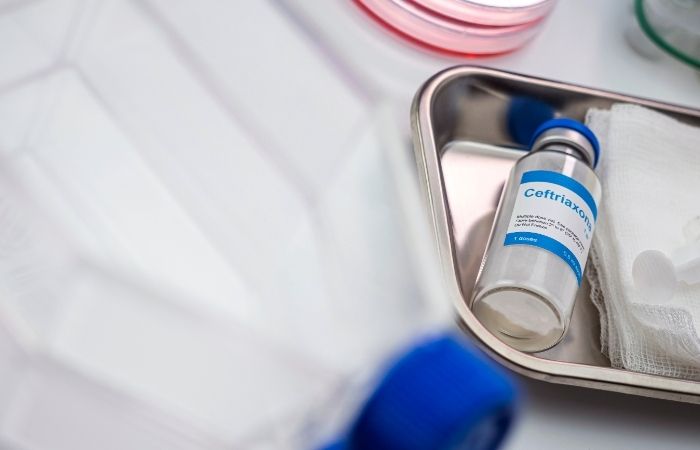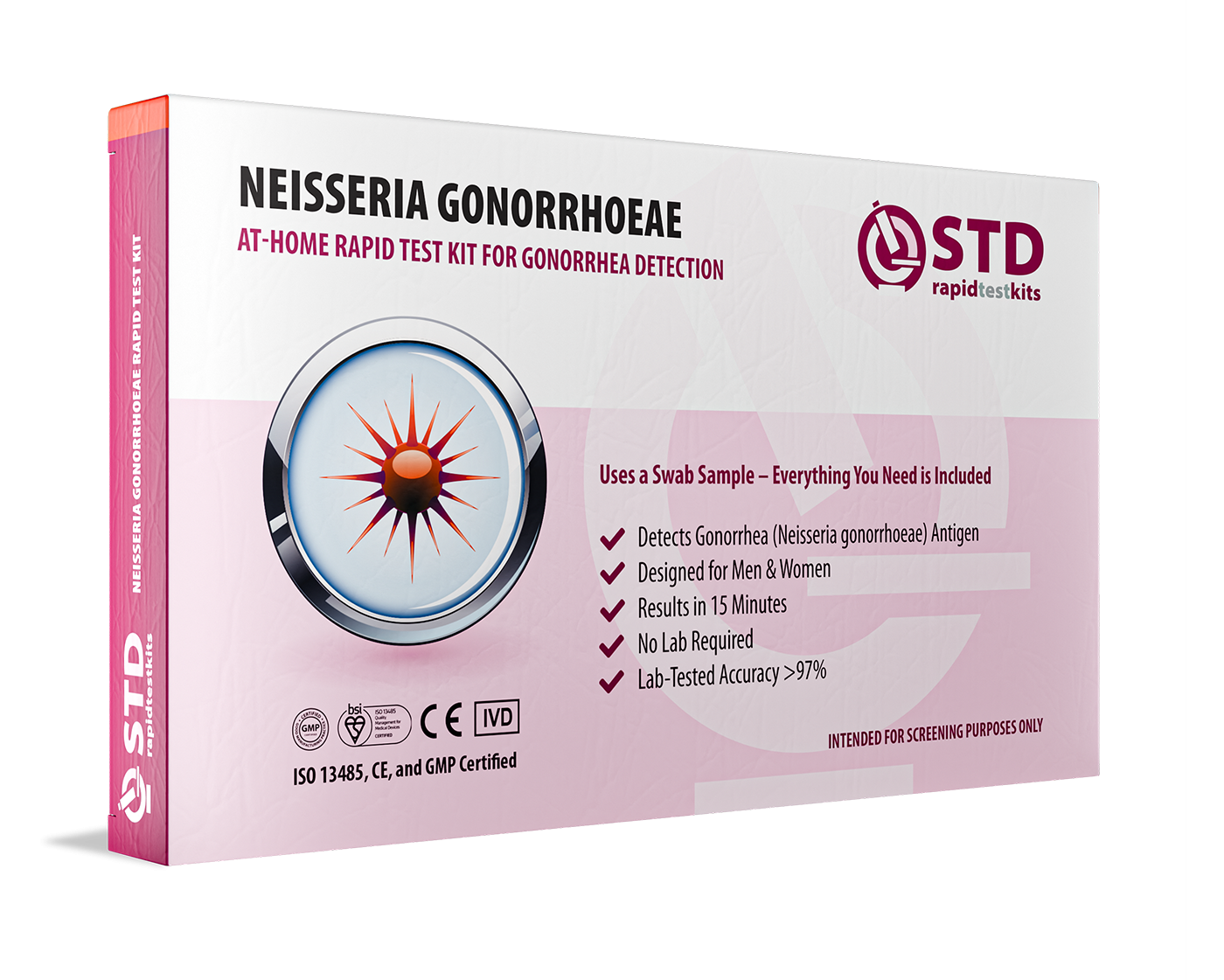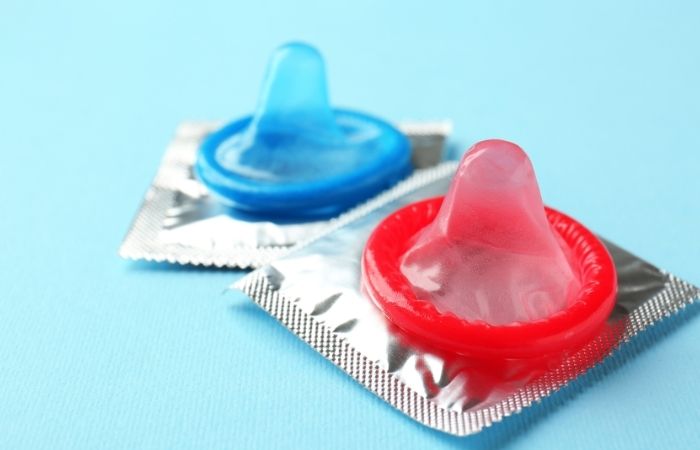Meet Ceftriaxone: Our “Break-Glass-in-Case-of-Emergency” Shot
Ceftriaxone is a third-generation cephalosporin, doctor-speak for a heavyweight antibiotic delivered as a single injection. Since 2010, guidelines from both the CDC and WHO have leaned on it because older drugs like ciprofloxacin and azithromycin lost their punch. “Ceftriaxone has been our safety net,” says Dr. Katy Sinka, gonorrhea lead at the UK Health Security Agency. “When that net tears, we all fall.”
But bacteria don’t sleep. Each time gonorrhea meets ceftriaxone, a few hardy bugs survive, swap genes, and raise tougher offspring. Once five percent of local samples outrun the drug, WHO recommends changing first-line therapy to stop feeding resistance.

People are also looking for: Chlamydia and Gonorrhea: How Are They Different?
The 5 % Rule: Why That Tiny Number Screams Trouble
The World Health Organization’s 2024 STI surveillance report explains the math: once resistance tops 5 %, treatments fail often enough that continuing business as usual does more harm than good. Patients need longer hospital stays, dual-drug cocktails, or, worst-case, experimental meds still in trials.
Picture it: out of every twenty friends in a crowded club, one could carry gonorrhea that laughs at the only shot left. Now multiply that across entire cities. That’s why Dr. Manica Balasegaram of GARDP warns,
“We’re a few mutations away from a post-antibiotic era for gonorrhea.”
Who’s Crossing the Line? Nations on the Hot List
According to the latest WHO data, at least nine countries, including Japan, Vietnam, parts of Australia, Kenya, and South Africa, have documented ceftriaxone resistance at or beyond the 5 % mark. In China, a 2024 CDC-MMWR brief detailed a cluster of ceftriaxone-proof cases linked to international travel. Meanwhile, the UK’s GRASP program logged 32 resistant infections since 2022, small in number, but each one a warning flare.
Travel, dating apps, and untreated infections speed the spread. “Pathogens don’t need passports,” notes Dr. Helen Zhou, an infectious-disease specialist in Melbourne. “They just need opportunity.”
Why Gonorrhea Evolves at Warp Speed
Neisseria gonorrhoeae swaps DNA like gamers trade cheat codes. A single sexual encounter can introduce mutations that block antibiotics from binding, or pump ceftriaxone back out of the bacterial cell. Over-prescribing and under-dosing antibiotics worldwide turbo-charges this evolution.
Experts compare it to weeds in a sidewalk crack: ignore the first sprout and roots take over. Routine screening plus consistent condom use, rips out those weeds before they seed the next sidewalk.
Check Your STD Status in Minutes
Test at Home with RemediumGonorrhea Test Kit

 For Men & Women
For Men & Women Results in Minutes
Results in Minutes No Lab Needed
No Lab Needed Private & Discreet
Private & DiscreetOrder Now $33.99 $49.00
When the Shot Fails: Real-World Consequences
So what actually happens when ceftriaxone doesn’t work? In Bangkok last year, clinicians documented a married couple in which gonorrhea resisted every standard dose; the husband needed a five-day IV cocktail, and the wife developed pelvic inflammatory disease before labs caught the mismatch. Untreated, drug-resistant gonorrhea can:
• inflame and scar the fallopian tubes, risking infertility
• cause epididymitis in men, a painful testicular swelling
• spread into the bloodstream, triggering septic arthritis or endocarditis
“We’re not talking about a routine clinic visit anymore,” warns Dr. Oye Adebayo, WHO AMR adviser. “We’re talking hospital beds, IV lines, and six-figure bills.”
New Weapons Loading: The Antibiotic Pipeline
The good news? Scientists aren’t sitting idle. Two front-runners are racing through late-stage trials:
- Zoliflodacin: An oral antibiotic that hammered 96 % of uncomplicated gonorrhea cases in a Phase III study (New England Journal of Medicine, 2025). If approved, it could replace injections with a single pill.
- Gepotidacin: Works on a totally different bacterial target, showing promise in tough strains that shrug at ceftriaxone (JAMA, 2024).
But both drugs could be years from pharmacy shelves. Until then, prevention and regular screening remain our best shields.
Your Defense Plan: Testing, Condoms, and Straight Talk
Here’s the bottom line: If you’re sexually active, you can’t guess whether you’ve met a resistant strain, you test. Swab or pee tests using NAAT technology spot gonorrhea fast, and many labs now flag resistance genes.
Combine that with consistent condom use (they still block 99 % of transmission pathways) and honest partner communication. As Dr. David Harper of the British Association for Sexual Health & HIV puts it:
“Safe sex and routine screening are boring until the day they save your love life, and your joints.”

People are also looking for: What’s the riskiest non-intercourse activity?
Big Moves: How Policy and Public Pressure Can Help
Governments are already tweaking guidelines, Australia’s 2025 update doubled the ceftriaxone dose and added oral doxycycline backup. The ECDC now funds free dual-therapy in hotspot clinics. But watchdogs like GARDP argue that real change requires:
• Stronger surveillance, more clinics culturing gonorrhea and sharing data
• Faster antibiotic approvals, shrinking red tape without skimping on safety
• Public education campaigns that ditch shame and focus on facts
And yes, individual voices matter: writing to health ministries, sharing reliable STI info, and normalizing conversation shifts policy faster than you’d think.
Hidden Fallout: Infertility, Arthritis & Blindness
Drug-resistant gonorrhea isn’t just about a stubborn discharge. Untreated, the bacteria can climb the reproductive tract, scar fallopian tubes, inflame testicles, or trigger septic arthritis. A 2023 Lancet Infectious Diseases review ties resistant strains to rising infertility in men and women across East Asia. Worse, bloodstream spread can infect the eyes, yes, gonorrheal blindness is a thing, turning a “simple” STD into a lifelong disability your insurance never saw coming.
If that sounds far-fetched, ask Jordan, 29, who needed emergency surgery after a resistant infection ballooned his knee.
“I thought gonorrhea just burned when you peed,” he says. “I never imagined IV antibiotics and an orthopedic ward.”
The Condom Comeback: Old Tech, New Urgency
Here’s some good news, condoms still block 99 % of gonorrhea transmission routes. A 2024 NEJM editorial calls barrier methods “the cheapest antimicrobial stewardship on Earth.” Latex allergy? Try polyisoprene or polyurethane brands, no natural-rubber proteins, same protection.
Pair condoms with regular testing and you slash risk even if a partner’s strain outsmarts antibiotics. Safe sex isn’t old-school; it’s superbug insurance.
Check Your STD Status in Minutes
Test at Home with Remedium3-in-1 STD Test Kit

 For Men & Women
For Men & Women Results in Minutes
Results in Minutes No Lab Needed
No Lab Needed Private & Discreet
Private & DiscreetOrder Now $69.00 $147.00
For all 3 tests
Hope on the Horizon: Dual Therapy & Next-Gen Drugs
Until zoliflodacin or gepotidacin hit pharmacy shelves, doctors in high-resistance zones use dual therapy: a double-dose of ceftriaxone plus oral doxycycline. Australia’s 2025 guidelines already recommend this combo. It’s not perfect, but it buys time as new molecules move through trials.
Dr. Julia Lopez, a microbiologist at WHO’s Gonococcal Antimicrobial Surveillance Programme, sums it up: “We’re loading the pipeline, but the bacteria are sprinting. Prevention and fast detection are still our best weapons.”
Policy Power: How Your Voice Drives Change
You don’t need a white coat to fight superbugs. Pressuring local health departments to fund routine culture tests, supporting AMR research charities, or even sharing clear info on social can move the needle. Remember: politicians tally inbox noise; a flood of “ fund STI labs” emails beats silence every time.
Global groups like GARDP and ReAct publish template letters, copy, paste, send, and suddenly you’re part of the solution.
FAQs
1. Is drug-resistant gonorrhea more painful?
Not always; symptoms can mirror regular strains, burning, discharge, but last longer and return after treatment.
2. Can condoms fail against resistant strains?
No, resistance affects antibiotics, not condom efficacy. Proper use blocks all gonorrhea, resistant or not.
3. How often should I test?
Sexually active adults: at least yearly; every 3–6 months if you have new or multiple partners.
4. Will resistant gonorrhea show up on home tests?
Yes, NAATs detect the bacteria itself, not drug response. Labs can then assess resistance.
5. Is ceftriaxone still safe?
Absolutely. The issue is bacterial resistance, not human toxicity. You can still receive it under medical guidance.
6. Could gonorrhea become untreatable?
That’s the fear. Without new drugs or better prevention, pockets of untreatable infection are possible.
7. Does dual therapy cure resistant cases?
Often, yes, high-dose ceftriaxone plus doxycycline clears many strains, but failures are rising.
8. Do I need both throat and genital tests?
If you give or receive oral sex, yes. Gonorrhea can hide in the throat without symptoms.
9. Can I get reinfected after treatment?
Definitely. Immunity is weak; unprotected sex with an infected partner restarts the cycle.
10. What if I’m allergic to ceftriaxone?
Doctors can use spectinomycin, gentamicin + azithromycin, or enrollment in new-drug trials.
Superbugs Don’t Stand a Chance When You’re Proactive
Drug-resistant gonorrhea may be sprinting, but you set the pace. Regular screening, consistent condom use, honest partner chats, and smart policy pressure turn the tide. Own your part, test today, protect every time, and spread facts, not infections.
Ready to lead by example? Start with the Combo STD Home Test Kit, fast, private, and shipped worldwide. Because the strongest defense is knowing your status.
Sources
1. CDC Treatment Guidelines 2024 – Gonorrhea
2. WHO STI Surveillance Report 2024
3. Lancet ID 2024 – Resistant Gonorrhea Case Study










